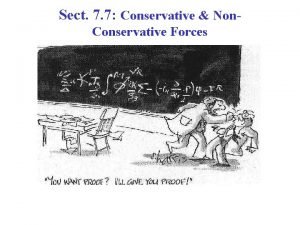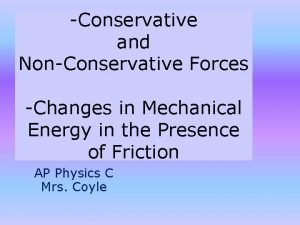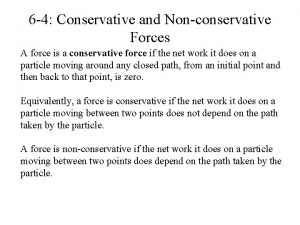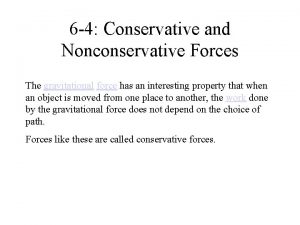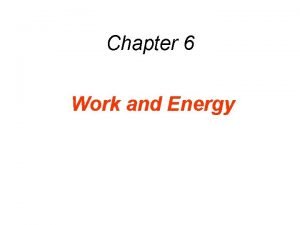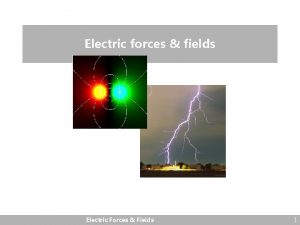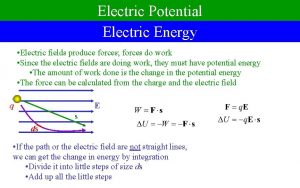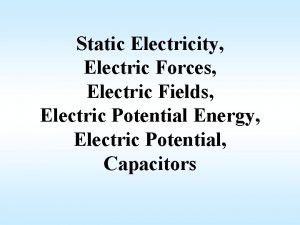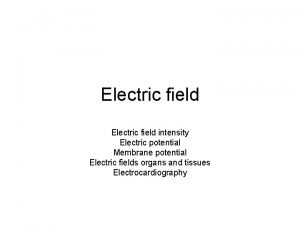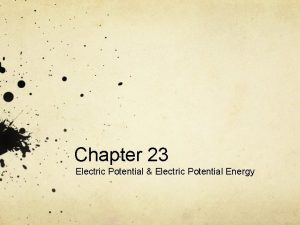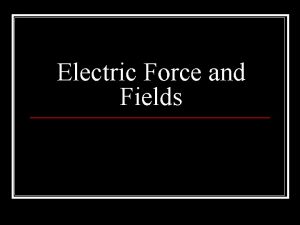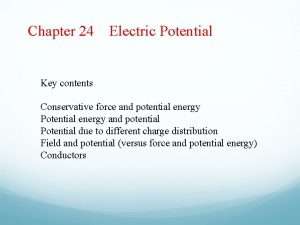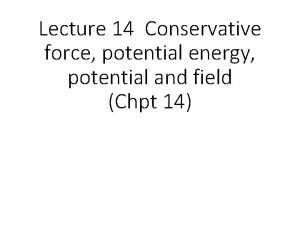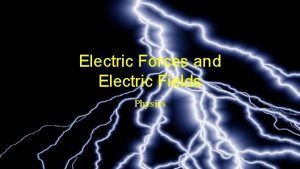Electric Potential CONSERVATIVE FORCES A conservative force gives

















![UNITS Potential Energy U: [Joule] [N m] (energy = work = force x distance) UNITS Potential Energy U: [Joule] [N m] (energy = work = force x distance)](https://slidetodoc.com/presentation_image/3863c911e22fe9ad2b77e549f1560c53/image-18.jpg)





- Slides: 23

Electric Potential

CONSERVATIVE FORCES A conservative force “gives back” work that has been done against it Gravitational and electrostatic forces are conservative Friction is NOT a conservative force

CONSERVATIVE FORCES A conservative force “gives back” work that has been done against it When we lift a mass m from ground to a height h, the potential energy of the mass increases by mgh. If we release the mass, it falls, picking up kinetic energy (or speed). As the mass falls, the potential energy is being converted into kinetic energy. By the time it reaches the ground, the mass has acquired a kinetic energy ½ mv 2 = mgh, and it’s potential energy is zero. The gravitational force ‘gave back’ the work that we did when we lifted the mass.

CONSERVATIVE FORCES A conservative force “gives back” work that has been done against it The gravitational force is a conservative force. The electric force is a conservative force as well. We will be able to define a potential energy associated with the electric force. A charge will have potential energy when in an electric field. Work done on the charge (by an external agent, or by the field) will result in changes in the potential energy of the charge.

CONSERVATIVE FORCES A conservative force “gives back” work that has been done against it When the total work done by a force F, moving an object over a closed loop, is zero, then the force is conservative F is conservative The circle on the integral sign indicates that the integral is taken over a closed path The work done by a conservative force, in moving and object between two points A and B, is independent of the path taken is a function of A and B only is NOT a function of the path selected

POTENTIAL ENERGY The change UAB in potential energy, associated with a conservative force, is the negative of the work done by that force, as it acts from point A to point B UAB = -WAB UAB = UB – UA = potential energy difference between A and B

POTENTIAL ENERGY Potential energy is a relative quantity, that means, it is always the difference between two values, or it is measured with respect to a reference point (usually infinity). We will always refer to, or imply, the change in potential energy (potential energy difference) between two points. The change UAB in potential energy, associated with a conservative force F, is the negative of the work done by that force, as it acts (over any path) from point A to point B B UAB = -WAB = - F. dr A UAB = UB – UA = potential energy difference between A and B

POTENTIAL ENERGY IN A CONSTANT FIELD E E L A • • B The potential energy difference between A and B equals the negative of the work done by the field as the charge q is moved from A to B UAB = UB – UA = -WAB = -FE L = q E L UAB = q E L

POTENTIAL ENERGY IN A CONSTANT FIELD E E L A • d. L • B Potential energy difference between A and B UAB = UB – UA = - q E. dl But E = constant, and E. dl = -1 E dl, then: UAB = - q E. dl = q E dl = q E L UAB = q E L UB - UA = q E L

POTENTIAL ENERGY IN A CONSTANT FIELD E The potential energy difference between A and B equals the negative of the work done by the field as the charge q is moved from A to B UAB = UB – UA = - FE L B A UAB = q E L when the +q charge is moved against the field

E L A • • B At which point (A or B) is the potential energy larger, a) For a positive charge +q ? b) For a negative charge –q ?

L B D • • A x An electric field E = a/x 2 points towards +x. Calculate the potential energy difference UAB = UB – UA for a charge +q

ELECTRIC POTENTIAL DIFFERENCE The potential energy U depends on the charge being moved. In order to remove this dependence, we introduce the concept of electric potential V Electric Potential = Potential Energy per Unit Charge VAB = UAB / q VAB = VB – VA Electric potential difference between the points A and B

ELECTRICAL POTENTIAL DIFFERENCE The potential energy U depends on the charge being moved. In order to remove this dependence, we introduce the concept of electrical potential V VAB = UAB / q Electrical Potential = Potential Energy per Unit Charge B VAB = UAB / q = - (1/q) q E. d. L = - E. d. L A VAB = Electrical potential difference between the points A and B

ELECTRIC POTENTIAL IN A CONSTANT FIELD E E L A • • B The electric potential difference between A and B equals the negative of the work per unit charge, done by the field, as the charge q is moved from A to B VAB = VB – VA = -WAB /q = q. E L/q = E L VAB = E L

ELECTRICAL POTENTIAL IN A CONSTANT FIELD E E L A • d. L • B VAB = UAB / q The electrical potential difference between A and B equals the work per unit charge necessary, for an external agent, to move a charge +q from A to B VAB = VB – VA = -WAB /q = - E. dl But E = constant, and E. dl = -1 E dl, then: VAB = - E. dl = E dl = E L VAB = E L UAB = q E L

POTENTIAL ENERGY IN A CONSTANT FIELD E UAB E ELECTRIC POTENTIAL IN A CONSTANT FIELD E VAB L A • • B VAB = UAB / q UAB = UB – UA = -WAB = -FE L VAB = VB – VA = -WAB /q = E L UAB = q E L VAB = E L
![UNITS Potential Energy U Joule N m energy work force x distance UNITS Potential Energy U: [Joule] [N m] (energy = work = force x distance)](https://slidetodoc.com/presentation_image/3863c911e22fe9ad2b77e549f1560c53/image-18.jpg)
UNITS Potential Energy U: [Joule] [N m] (energy = work = force x distance) Electric Potential V: [Joule/Coulomb] [Volt] (potential = energy/charge) Electric Field E: [N/C] [V/m] (electric field = force/charge = potential/distance)

Cases in Which the Electric Field E is not Aligned with d. L E B A VAB = - E. dl • A • B Since F = q E is conservative, the field E is conservative. Then, the electrical potential difference does not depend on the integration path. One possibility is to integrate along the straight line AB. This is convenient in this case because the field E is constant, and the angle between E and d. L is constant. B E. dl = E dl cos VAB = - E cos dl = - E L cos A

Cases in Which the Electric Field E is not Aligned with d. L E A X • L • • B C VAB = - E. dl A B Another possibility is to choose a path that goes from A to C, and then from C to B VAB = VAC + VCB Thus, VAB = E X VAC = E X VCB = 0 (E d. L) but X = L cos = - L cos VAB = - E L cos

Rank the points A, B, and C in order of decreasing potential energy, for a charge +q is placed at the point.

Equipotential Surfaces (lines) A E B Since the field E is constant VAB = E L X L E Then, at a distance X from plate A VAX = E X All the points along the dashed line, at X, are at the same potential. The dashed line is an equipotential line L

Equipotential Surfaces (lines) X E It takes no work to move a charge at right angles to an electric field E d. L E • d. L = 0 V = 0 L If a surface (line) is perpendicular to the electric field, all the points in the surface (line) are at the same potential. Such surface (line) is called EQUIPOTENTIAL ELECTRIC FIELD
 Is electric potential conservative
Is electric potential conservative Electric field lines
Electric field lines Conservative and non conservative force
Conservative and non conservative force Force conservative et non conservative
Force conservative et non conservative Force conservative et non conservative
Force conservative et non conservative Gravitational force is conservative
Gravitational force is conservative Physics 03-06 impulse and momentum answer key
Physics 03-06 impulse and momentum answer key Define electric potential and potential difference.
Define electric potential and potential difference. Electrostatic potential difference
Electrostatic potential difference Electric potential
Electric potential Potential energy of a system of charges
Potential energy of a system of charges Expression for electric potential difference
Expression for electric potential difference Formula of electric field
Formula of electric field Electric potential and electric field
Electric potential and electric field Electric charges and electric forces lesson outline
Electric charges and electric forces lesson outline Conservation of energy
Conservation of energy Force conservative
Force conservative Work energy
Work energy How to find pressure potential
How to find pressure potential Water potential definition biology
Water potential definition biology Water potential
Water potential Graded potential vs action potential
Graded potential vs action potential Graded potentials
Graded potentials Definition of graded potential
Definition of graded potential


